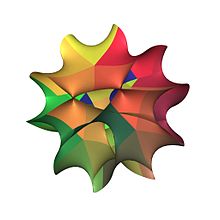Calabi–Yau manifold
Particularly in superstring theory, the extra dimensions of spacetime are sometimes conjectured to take the form of a 6-dimensional Calabi–Yau manifold, which led to the idea of mirror symmetry.They were originally defined as compact Kähler manifolds with a vanishing first Chern class and a Ricci-flat metric, though many other similar but inequivalent definitions are sometimes used.The motivational definition given by Shing-Tung Yau is of a compact Kähler manifold with a vanishing first Chern class, that is also Ricci flat.The simplest examples where this happens are hyperelliptic surfaces, finite quotients of a complex torus of complex dimension 2, which have vanishing first integral Chern class but non-trivial canonical bundle.On the other hand, their double covers are Calabi–Yau manifolds for both definitions (in fact, K3 surfaces).This follows from Yau's proof of the Calabi conjecture, which implies that a compact Kähler manifold with a vanishing first real Chern class has a Kähler metric in the same class with vanishing Ricci curvature.There are many other inequivalent definitions of Calabi–Yau manifolds that are sometimes used, which differ in the following ways (among others): The fundamental fact is that any smooth algebraic variety embedded in a projective space is a Kähler manifold, because there is a natural Fubini–Study metric on a projective space which one can restrict to the algebraic variety.By definition, if ω is the Kähler metric on the algebraic variety X and the canonical bundle KX is trivial, then X is Calabi–Yau.Moreover, there is unique Kähler metric ω on X such that [ω0] = [ω] ∈ H2(X,R), a fact which was conjectured by Eugenio Calabi and proved by Shing-Tung Yau (see Calabi conjecture).In one complex dimension, the only compact examples are tori, which form a one-parameter family.In two complex dimensions, the K3 surfaces furnish the only compact simply connected Calabi–Yau manifolds., such as the complex algebraic variety defined by the vanishing locus ofOther examples can be constructed as elliptic fibrations,[3] as quotients of abelian surfaces,[4] or as complete intersections.Enriques surfaces and hyperelliptic surfaces have first Chern class that vanishes as an element of the real cohomology group, but not as an element of the integral cohomology group, so Yau's theorem about the existence of a Ricci-flat metric still applies to them but they are sometimes not considered to be Calabi–Yau manifolds.However, the Enriques surface subset do not conform entirely to the SU(2) subgroup in the String theory landscape.In three complex dimensions, classification of the possible Calabi–Yau manifolds is an open problem, although Yau suspects that there is a finite number of families (albeit a much bigger number than his estimate from 20 years ago).In turn, it has also been conjectured by Miles Reid that the number of topological types of Calabi–Yau 3-folds is infinite, and that they can all be transformed continuously ( through certain mild singularizations such as conifolds) one into another—much as Riemann surfaces can.[5] One example of a three-dimensional Calabi–Yau manifold is a non-singular quintic threefold in CP4, which is the algebraic variety consisting of all of the zeros of a homogeneous quintic polynomial in the homogeneous coordinates of the CP4.Some discrete quotients of the quintic by various Z5 actions are also Calabi–Yau and have received a lot of attention in the literature.For every positive integer n, the zero set, in the homogeneous coordinates of the complex projective space CPn+1, of a non-singular homogeneous degree n + 2 polynomial in n + 2 variables is a compact Calabi–Yau n-fold.Essentially, Calabi–Yau manifolds are shapes that satisfy the requirement of space for the six "unseen" spatial dimensions of string theory, which may be smaller than our currently observable lengths as they have not yet been detected.Further extensions into higher dimensions are currently being explored with additional ramifications for general relativity.In the most conventional superstring models, ten conjectural dimensions in string theory are supposed to come as four of which we are aware, carrying some kind of fibration with fiber dimension six.Compactification on Calabi–Yau n-folds are important because they leave some of the original supersymmetry unbroken.More precisely, in the absence of fluxes, compactification on a Calabi–Yau 3-fold (real dimension 6) leaves one quarter of the original supersymmetry unbroken if the holonomy is the full SU(3).When fluxes are included the supersymmetry condition instead implies that the compactification manifold be a generalized Calabi–Yau, a notion introduced by Hitchin (2003).F-theory compactifications on various Calabi–Yau four-folds provide physicists with a method to find a large number of classical solutions in the so-called string theory landscape.Connected with each hole in the Calabi–Yau space is a group of low-energy string vibrational patterns.For example, Andrew Strominger and Edward Witten have shown that the masses of particles depend on the manner of the intersection of the various holes in a Calabi–Yau.In other words, the positions of the holes relative to one another and to the substance of the Calabi–Yau space was found by Strominger and Witten to affect the masses of particles in a certain way.
Calabi-Yau (play)algebraicdifferential geometrymanifoldRicci flatnesstheoretical physicssuperstring theoryspacetimemirror symmetryEugenio CalabiShing-Tung YauCalabi conjecturecomplex manifoldsK3 surfacescomplex dimensionsdimensionsKähler manifoldsChern classKähler manifoldcanonical bundlestructure grouptangent bundleunitary groupspecial unitary groupholonomy
S
U
(
n
)
{\displaystyle SU(n)}
hyperelliptic surfacessimply connectedEnriques surfacesfundamental groupHodge numbersGorensteinalgebraic varietyprojective spaceFubini–Study metricflat metricelliptic curvecomplete intersectionsabelian surfacesproper subgroupEnriques surfaceString theory landscapeMiles ReidconifoldsRiemann surfacesquintic threefoldpolynomialBarth–Nieto quinticzero setweighted projective spaceadjunction formulahyper-Kähler manifoldslarge extra dimensionsbraneworldD-branegeneral relativitystring theoryfibrationCompactificationsupersymmetryfluxestype IIA supergravityF-theoryfamiliesAndrew StromingerEdward WittenVictor Ginzburgnoncommutative algebraic geometrySheldon CooperYoung Sheldonepisode 53 Body ProblemHalf-Life 2G2 manifoldReid, MilesMathematische AnnalenCalabi, EugenioFox, Ralph H.Spencer, Donald C.Tucker, Albert W.Princeton University PressBibcodeHitchin, NigelCiteSeerXCommunications on Pure and Applied MathematicsBesse, Arthur L.Springer-VerlagGreene, BrianJoyce, DominicWorld ScientificOxford University PressWolfram Demonstrations ProjectWeisstein, Eric W.MathWorldcomplete intersectionStringsCosmic stringsHistory of string theoryFirst superstring revolutionSecond superstring revolutionNambu–Goto actionPolyakov actionBosonic string theoryType I stringType II stringType IIA stringType IIB stringHeterotic stringN=2 superstringString field theoryMatrix string theoryNon-critical string theoryNon-linear sigma modelTachyon condensationRNS formalismGS formalismString dualityT-dualityS-dualityU-dualityMontonen–Olive dualityGravitonDilatonTachyonRamond–Ramond fieldKalb–Ramond field